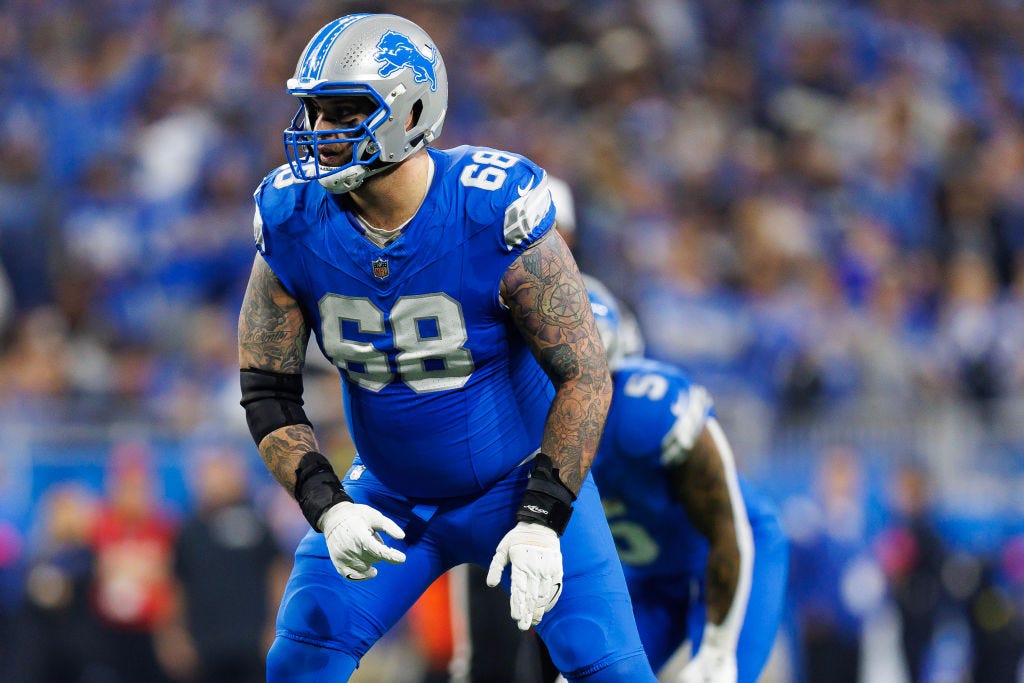Caution Flags in Allen Park: Lions Open Camp With Surprise Injured-List Wave Headlined by Taylor Decker and Levi Onwuzurike—Is This Just Load Management or the First Big Stress Test of Detroit’s 2025 Push?
The Detroit Lions have been working for three years to graduate from plucky overachiever to annual problem, and a big part of that climb has been trench continuity—knowing where your cornerstone left tackle lines up every snap and trusting that your interior defensive rotation will stay fresh enough to punch for four quarters. So when the team reported for the start of training camp and several key names landed on injured designations, including franchise left tackle Taylor Decker and interior disruptor Levi Onwuzurike, a ripple of unease rolled through the fan base that has spent months daydreaming about deep January football. Context matters, and this is one of those moments when NFL transaction language—Active/PUP, Active/NFI, Reserve lists, the difference between “can practice tomorrow” and “out a month”—gets weaponized by anxiety. Decker on a list looks scary; Onwuzurike on a list raises déjà vu; multiple depth pieces joining them starts the “here we go again” chorus. Yet opening-camp list placements live in a gray zone between precaution and problem, and understanding how Detroit has managed health windows under Dan Campbell and GM Brad Holmes helps decode what this means for the season rather than just the week.
Let’s start with the mechanics because the designations shape the stakes. Players placed on the active versions of the Physically Unable to Perform (PUP) list or Non-Football Injury (NFI) list at the start of camp still count toward the 90‑man roster and can be activated at any time; they’re simply barred from practicing until medically cleared. The move can be conservative—teams often slide veterans with lingering tweaks, post‑procedure ramp‑ups, or soft‑tissue flags onto PUP for a few days to avoid early overload—because once a player participates in practice, he becomes ineligible for PUP protection later. Conversely, if a player remains on PUP through roster cutdowns and is shifted to Reserve/PUP, he must miss a set number of regular-season games. That’s the big cliff teams try to avoid unless necessary. So opening-camp PUP is not a season death sentence; it’s a roster tool, a caution cone placed around anyone the medical and performance staff wants to bring along in measured increments. Detroit has used that tool before to manage workload for veterans coming off minor offseason scopes or conditioning setbacks, and more often than not those players are back in individual drills before the first fully padded practice.
Taylor Decker’s inclusion still jolts because of what he represents. He’s been the blind‑side keystone through regime transition, scheme evolution, quarterback reshuffling, culture overhaul—name the turbulence and Decker was the anchor. Even when he’s battled through dings, his presence has stabilized protection calls and set the tone for the nastiness Campbell wants on the edge of the pocket. The left tackle spot is football infrastructure; you do not want to test its backup wiring in August if you can help it. Yet that is precisely why an active-camp designation can be a form of respect, not alarm—if Decker reported with anything less than absolute green‑light health, the staff would rather slow his ramp, protect his early load, and free up developmental reps for swing tackles in need of live speed. Detroit’s schedule—and its ambitions—demand Decker in September, not July heroics. Expect the team to stage his return: conditioning work, side-field agility, limited individual pass‑set periods, then incremental team reps once soreness responses look clean. If he clears those steps without setback, this camp footnote fades; if he lingers into multiple padded weeks, the conversation gets louder and roster contingency planning accelerates.
Levi Onwuzurike’s listing carries a different emotional charge because his path already runs through start‑stop health chapters. Drafted for quickness and length, slowed by back trouble, ramped cautiously, and finally beginning to show rotational impact, he represents both upside and fragility in Detroit’s defensive build. The Lions don’t need him to be a 50‑snap nose bully; they need him to be the disruptive interior changeup who keeps Alim McNeill and the edge rushers from absorbing every double and slide. When he’s right, Levi’s first step crosses a guard’s face before the block settles, which shortens quarterback depth and flattens run lanes. When he’s managing pain or conditioning, that pop dulls—and the scheme loses one of its most valuable leverage tools. Opening camp with him limited could be strategic load management tied to offseason maintenance work or could signal that the staff intends to calibrate expectations toward sub‑package usage early. Either way, the decision to list him now preserves roster optionality later; Detroit can activate him when the medical staff is satisfied he can stack days, or hold him and explore rotation alternatives if recovery stalls. Given Campbell’s established pattern—protect players, preach honesty, weaponize depth—the early designation feels more like a chess move than panic siren, but the next two weeks will tell the story.
Beyond the headline names, “several players” landed on camp lists, and that cluster matters because roster math in August is a cascading puzzle. A guard on PUP means more first‑team guard reps for a fringe interior swing candidate; a safety on NFI opens split‑safety install snaps for a rookie; a wideout on Active/PUP forces special‑teams reshuffling that can elevate a gunner into roster contention. Detroit has prided itself on building a roster where core contributors come from everywhere—late picks, undrafted grinders, special‑teams aces turned rotation guys—and camp availability drives opportunity. Injuries, even short‑term ones, are the harsh equalizer that turns theoretical depth into reality. In that sense, the Lions’ early list wave will accelerate evaluation: who communicates protection calls next to Penei Sewell when Decker is out? Which interior defender can two‑gap long enough to earn early-down snaps if Levi’s ramp is staged? Can a developmental tackle survive Hutchinson in one‑on‑ones without holding? These reps reveal what the back half of the 53 will look like, and Detroit’s front office leans into that information.
The fan anxiety is understandable; the last thing Lions supporters want after tasting real contention is to see durable foundational pieces in yellow tape. But early attrition also offers strategic upside if managed correctly. Coaches can install expanded swing plans now, not in desperate October practice windows. Goff’s pocket awareness gets stress‑tested behind shuffle lineups, which can sharpen his rhythm and hot‑route command. The running game’s blocking rules get cross‑trained so that if a line shuffle hits in Week 7, communication muscle memory exists. Defensively, leaning on younger interior bodies in camp forces Jack Campbell and Alex Anzalone to diagnose fits without the comfort of veteran space‑eaters, tightening their keys. Teams that survive late-season attrition almost always trace that resilience back to uncomfortable August reps when second‑teamers became accidental starters for a week.
Dan Campbell’s tone when addressing these openings will set the external mood. Historically, he’s been blunt: if a player is long‑term, he’ll say they’re not close; if he expects a quick ramp, he’ll cast it as procedural. That transparency has built trust in a market conditioned by decades of vague “day‑to‑day” optimism that dissolved on game day. Listen less to the designation label and more to how Campbell frames workload progression. If he emphasizes conditioning phases and target dates tied to specific padded practice benchmarks, Detroit is in management mode. If he deflects into “we’ll see” territory two weeks in, contingency questions heat up. Either way, the early decision to list Decker and Onwuzurike protects Detroit’s right to be cautious—an organizational value that has paid off in reduced recurrence risk across recent seasons.
From a scheme standpoint, losing Decker practice time nudges Detroit to reexamine its left‑side protection menu. Decker’s chemistry with the guard inside him allows the Lions to fan, slide, and screen out of looks that assume elite set depth and recovery. A backup may require tighter splits, more chip help, altered launch points, and increased boot action away from blind‑side exposure. That experimentation in camp is gold; offensive coordinator transition aside, knowing which protections hold with the two’s group can save a game if Decker tweaks something mid‑season. Expect more inside move counters drilled for the replacement tackles, because opponents will test vertical sets immediately if Decker isn’t on the field.
On defense, Levi’s absence will spotlight Alim McNeill’s stamina and the development of the second wave—Brodric Martin’s pad discipline, any veteran camp invite’s ability to anchor, and whether Detroit trusts a bigger end (think John Cominsky archetype) to kick inside more frequently. It will also influence sub‑package creativity: if interior push is compromised, Glenn could dial more creeper pressures—bring a linebacker, drop an end—to generate inside movement. Those calls depend on communication and disguise; camp reps without your full complement of linemen become rehearsal space for the chess the Lions will have to play if injuries persist into the season.
There’s an emotional through‑line worth watching: the Lions’ identity is built on visible strain—linemen sprinting to celebrate defensive stops, receivers finishing blocks, defenders rallying to the ball after long drives. Early adversity feeds that identity if framed correctly. Campbell can—and likely will—turn the injured‑list wave into a daily mantra: do your job, protect the guy next to you, earn snaps because this league never hands you anything. For a roster still young in championship experience, that lesson landing in July rather than December might be the quiet advantage no one sees when the wins are tallied.
Ultimately, opening camp with Decker, Onwuzurike, and several others sidelined is neither catastrophe nor comfort; it’s a fork that forces Detroit to prove the depth culture it has preached is real. If Decker is activated within days and ramps clean, the news cycle shrinks to a cautionary footnote. If Onwuzurike stages in and flashes late‑camp explosiveness, optimism rebounds. If either lingers, the Lions will lean into contingency frameworks built precisely for this moment—swing linemen elevated, rotation heavy inside, more tempo to tire rushers who think they smell blood. Detroit has grown past the stage where one injury derails belief; now it must prove that growth holds under fire. Opening-camp lists are the first sparks. How the Lions handle the next few weeks will tell whether they’re fireproof enough to chase the long burn of a season built for something bigger than respect.



